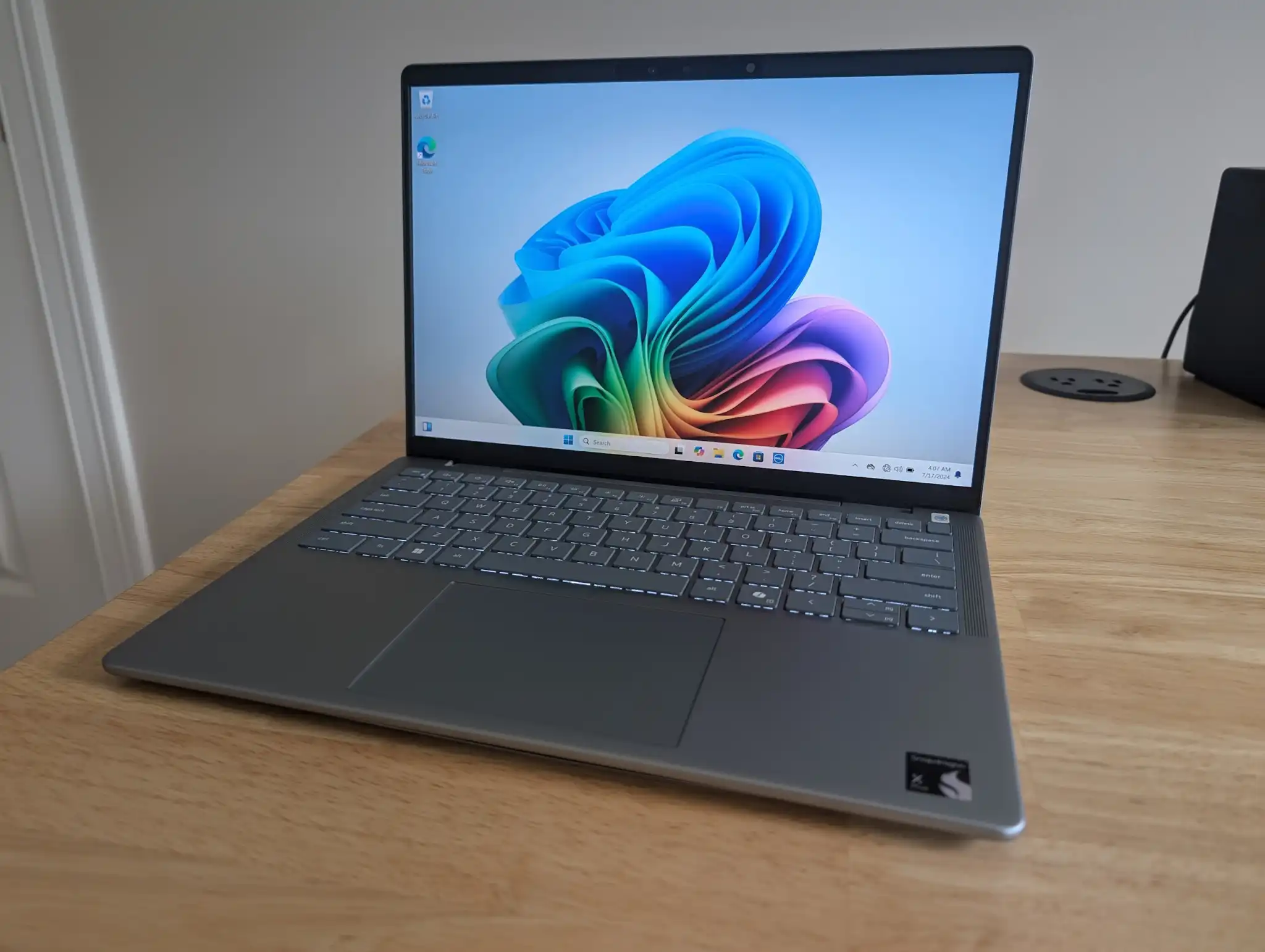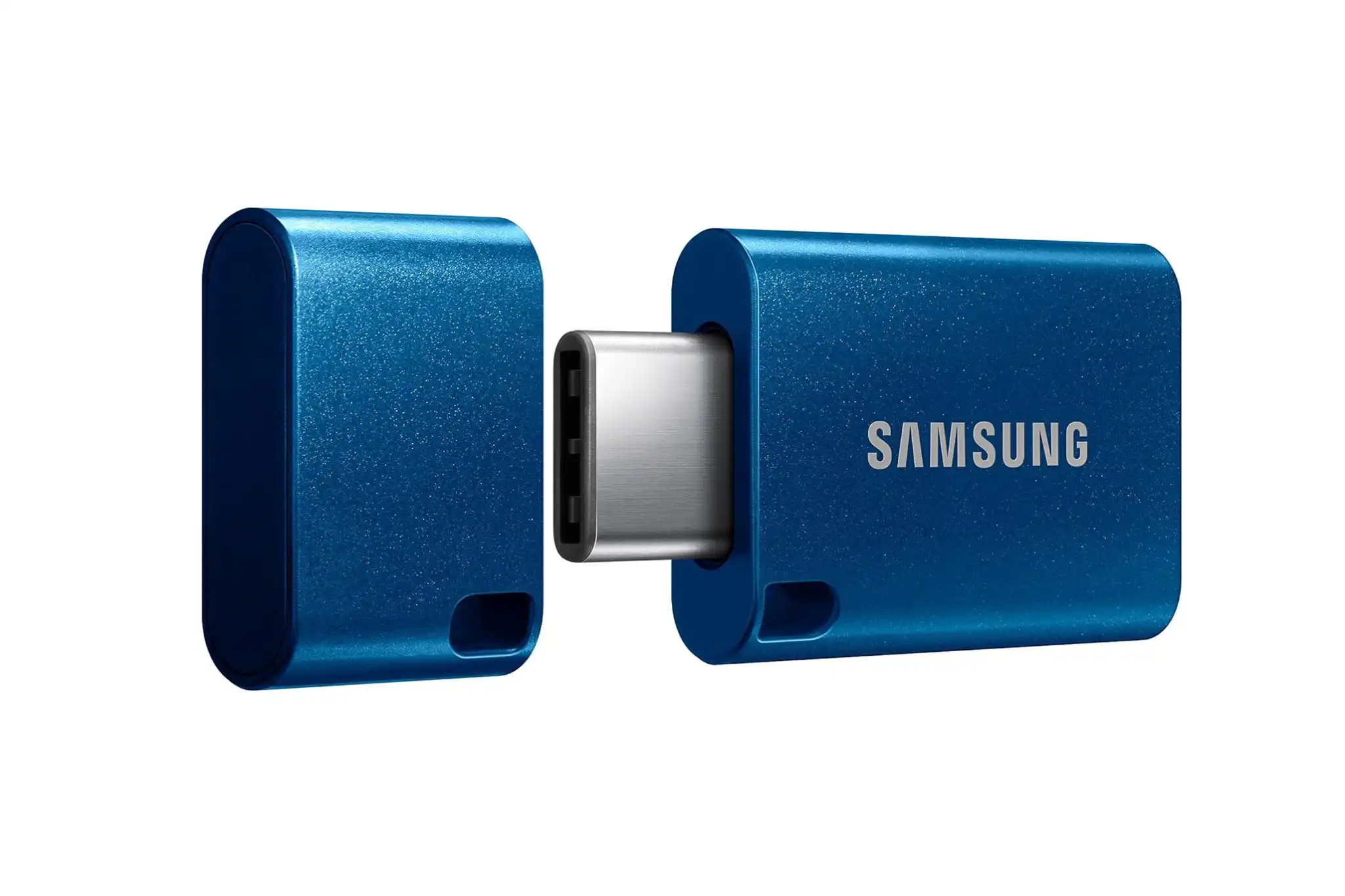The Dell Inspiron 14 Plus 7441 is Dell’s entry in the first wave of Copilot+ PCs with Qualcomm Snapdragon X hardware. Dell delivered a perfectly serviceable PC here, and many people would be happy using this laptop for the kind of light tasks a Snapdragon PC excels at.
But this PC doesn’t stand out alongside other Snapdragon X laptops like Microsoft’s Surface Laptop, Lenovo’s Yoga Slim 7x, and Samsung’s Galaxy Book4 Edge. Qualcomm and Microsoft are proud of the number of PC manufacturers delivering Snapdragon X laptops at launch and this is definitely a perfectly fine entry from Dell. It feels like this machine was made to check a box: Yes, Dell also has a Snapdragon laptop. Still, this is a fine laptop — and, at the right sale price, it may be a great choice!
Like other Copilot+ PCs with Snapdragon X hardware, the Dell Inspiron 14 Plus (7441) is an Arm-based laptop. As discussed in PCWorld’s reviews of the Surface Laptop, Surface Pro, and Lenovo Yoga Slim 7x, application compatibility is decent but not perfect. Most applications run just fine, but some applications may not run at all or may run with bad performance. The situation is improving, but it’s early days for this new hardware. Also, despite the AI hook the industry is using to market these laptops, those exclusive Copilot+ PC AI features aren’t very interesting.
Dell Inspiron 14 Plus: Specs
The Dell Inspiron 14 Plus 7441 is another model in Dell’s existing Dell Inspiron 14 Plus lineup. This model comes with Qualcomm Snapdragon X hardware instead of an Intel CPU, and it’s one of the first Copilot+ PCs to arrive. All Snapdragon X Plus and Elite chips include a neural processing unit (NPU) capable of 40 trillion operations per second (TOPS) as well as a Qualcomm Adreno GPU.
The base model Dell Inspiron 14 Plus (and the model we reviewed) comes with Snapdragon X Plus hardware. That’s the lowest tier of Snapdragon X hardware available – the other models are all branded as “Snapdragon X Elite.” Snapdragon X Plus has 10 cores with no “dual-core boost” feature while Snapdragon X Elite has 12 cores with a dual-core boost feature that can ramp up performance. However, you can spend more to upgrade this laptop to Snapdragon X Elite hardware.
Aside from the base-model Microsoft Surface Laptop, which matches the Dell Inspiron 14 Plus’s starting pricing, I’ve seen most Copilot+ PCs ship with Qualcomm Snapdragon X Elite hardware as standard so far.
Dell only offers this laptop with 16 GB of memory – there’s no option for 32 GB of memory, as with some other Copilot+ laptops with Qualcomm Snapdragon X Elite hardware.
Our review model did have 512 GB of storage. For that much storage, this particular laptop $100 cheaper than a comparable Surface Laptop. But a Dell Inspiron 14 Plus with 256GB of storage will cost you $999, which is the same price as a base model Surface Laptop with the same storage.
- CPU: Qualcomm Snapdragon X Plus X1P-64-100
- Memory: 16 GB LPDDR5X RAM
- Graphics/GPU: Qualcomm Adreno
- Display: 14-inch 2560×1600 IPS display with 60Hz refresh rate, touch screen, and 16:10 aspect ratio
- Storage: 512 GB PCIe SSD
- Webcam: 1080p webcam
- Connectivity: 2x USB Type-C (USB4 Full Function), 1x USB Type-A (USB 3.2 Gen 1), 1x combo audio jack, 1x microSD card reader
- Networking: Wi-Fi 7, Bluetooth 5.4
- Biometrics: IR camera and fingerprint reader
- Battery capacity: 54 Watt-hours
- Dimensions: 8.81 x 12.36 x 0.67 inches
- Weight: 3.17 pounds
- MSRP: $1,099 as tested ($999 starting price)
Dell Inspiron 14 Plus: Design and build quality

IDG / Chris Hoffman
The Dell Inspiron 14 Plus’s design is fine. Despite the flashy new internals thanks to the new Snapdragon X Plus ARM hardware, the laptop’s body is based on Dell’s existing Inspiron designs. This is the spitting image of the Intel-powered Dell Inspiron 14 Plus, which we called a well-rounded machine when we reviewed it earlier this year.
It’s a fine design, and there’s nothing objectionable about it. There are lots of smooth edges. The laptop’s chassis uses a good amount of aluminum, but there are also plastic elements: For example, around the display. There’s not any noticeably flex while typing, but there is a bit of flex while handling the display.
The modern Inspiron design does have a neat little feature. When you tilt the screen back, the keyboard will angle up towards you. It’s a nice touch.
The Dell Inspiron 14 Plus (7441) is a perfectly fine Copilot+ laptop with Snapdragon X Plus hardware. It has decent build quality, a nice keyboard, and good speakers. If you’re looking for an Arm-based Windows laptop, you can’t really go wrong with it.
Microsoft has set the Copilot+ PC standard with its Surface Laptop. There’s really no writing about a Copilot+ PC with Snapdragon X hardware without mentioning the Surface Laptop, and the Surface Laptop’s all-metal construction feels much more solid and premium. That’s a big thing to keep in mind when these machines start at the same price and both have Snapdragon X Plus hardware.
Additionally, while this is a nice compact laptop and it’s reasonably light, it’s not the lightest Copilot+ PC. Weighing in at 3.17 pounds, this is heavier than Microsoft’s Surface Laptop and Lenovo’s Yoga Slim 7x.
The chassis is nice enough. It’s fine and perfectly serviceable. But it just doesn’t stand out in comparison to similarly priced Copilot+ laptops.
Dell Inspiron 14 Plus: Keyboard and trackpad
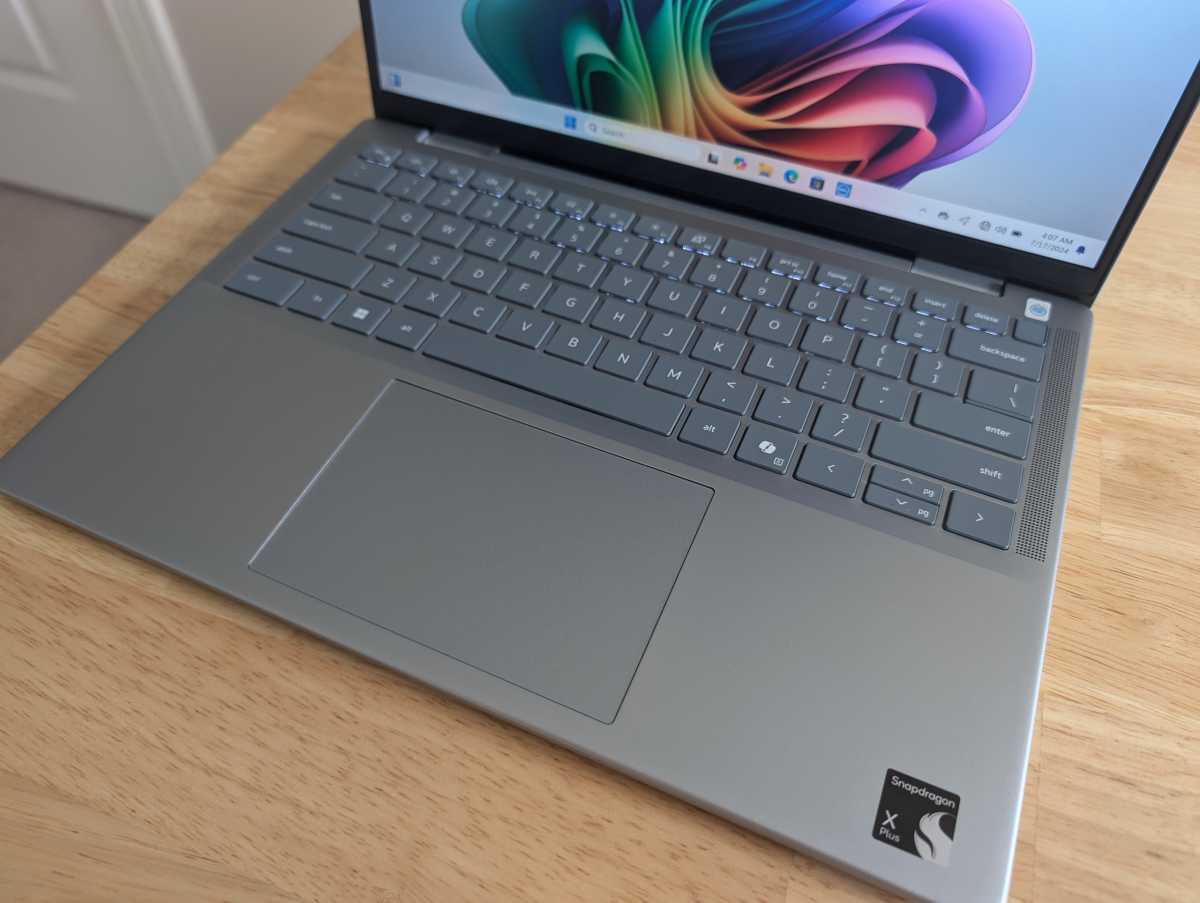
IDG / Chris Hoffman
The Dell Inspiron 14 Plus has a good keyboard. I enjoyed typing on it – it’s not mushy, although it’s not the snappiest, most premium laptop keyboard I’ve used. The entire surface of the keyboard deck feels comfortable. It also includes white backlighting.
When we reviewed the Intel model, we said it had “an unreasonably good keyboard,” and I think that’s carried through to the Snapdragon version of the laptop here. It’s a good keyboard, but I’m not sure that feature alone is enough to stand out in the Copilot+ PC market. Lots of these Copilot+ PCs have nice keyboards.
The trackpad is a reasonably good size and is fine to use. I didn’t have any problems with palm rejection. But the Surface Laptop offers a haptic trackpad at the same price point, and in my experience it offers a much nicer trackpad experience.
Dell Inspiron 14 Plus: Display and speakers
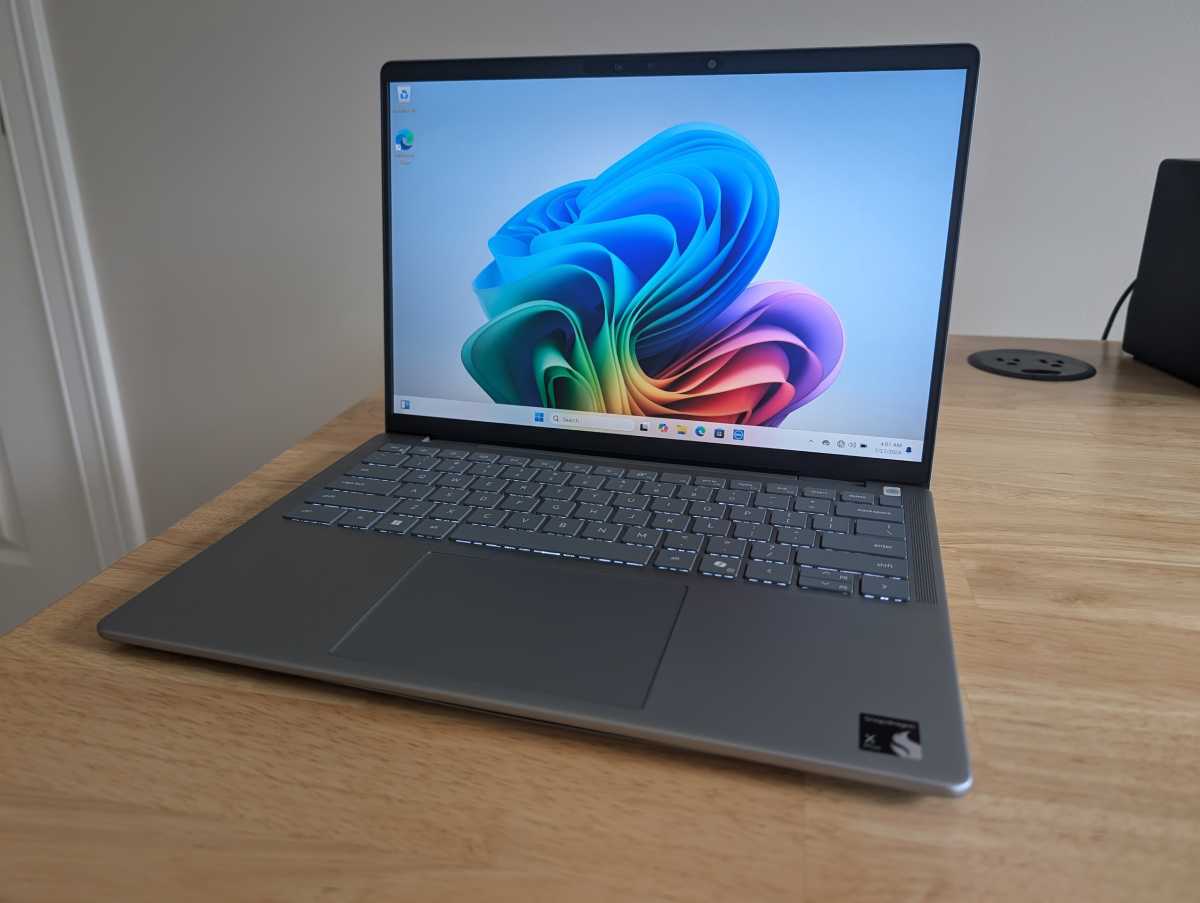
IDG / Chris Hoffman
The Dell Inspiron 14 Plus includes a good IPS display. With a 2560×1600 resolution, 16:10 aspect ratio, 60Hz refresh rate, 400 nits of brightness, and a touchscreen, it’s not something you can complain about. This isn’t the vivid OLED display offered by some Copilot+ PCs like the Lenovo Yoga Slim 7 or the Samsung Galaxy Book4 Edge, but I was plenty happy using it. (Of course, those OLED displays are extremely beautiful – and I really would prefer an OLED display).
The 13.8-inch Surface Laptop offers a slightly smaller display with a slightly lower resolution, but it also offers double the refresh rate at 120Hz and up to 600 nits of brightness. So, while the Dell Inspiron 14 Plus’s display is fine, the Surface Laptop outshines it — literally, thanks to that higher brightness.
Like the keyboard, the speakers on this machine are surprisingly good. There are a total of four speakers, and they’re plenty loud, reasonably clear, and even have more bass than I’d typically expect from a laptop of this size.
Dell Inspiron 14 Plus: Webcam, microphone, biometrics

IDG / Chris Hoffman
The Dell Inspiron 14 Plus has a 1080p webcam. It’s a good webcam that worked well in a variety of lighting conditions. Thanks to the neural processing unit (NPU) and Copilot+ PC features, you have access to a variety of extra effects for the webcam thanks to Windows Studio Effects. For example, you can make it look like you’re always making eye contact with the camera or add various effects to your visage in real time.
Additionally, Dell also includes a physical privacy shutter, and you can turn off the camera by sliding the shutter switch above the webcam.
This machine also includes a presence sensor, so it can automatically go to sleep when you step away and turn on when you come back. Microsoft omitted this feature from the Surface Laptop for some reason.
The dual-microphone hardware in this laptop works well, too, and it did a good job of picking up my voice without a lot of background noise. The combination of a nice webcam and microphone with long battery life — not to mention the good speakers — means this will be a great laptop for online meetings.
Biometrics are one area where the Dell Inspiron 14 Plus stands above the Surface Laptop. This machine includes both an IR camera for facial recognition as well as a fingerprint reader in the power button at the top-right corner of the keyboard. While I personally prefer the facial recognition on a laptop — it will log you in quickly, once you open up the laptop — some people do prefer the fingerprint reader, and you have both here. Both the fingerprint reader and IR camera work well.
Dell Inspiron 14 Plus: Connectivity
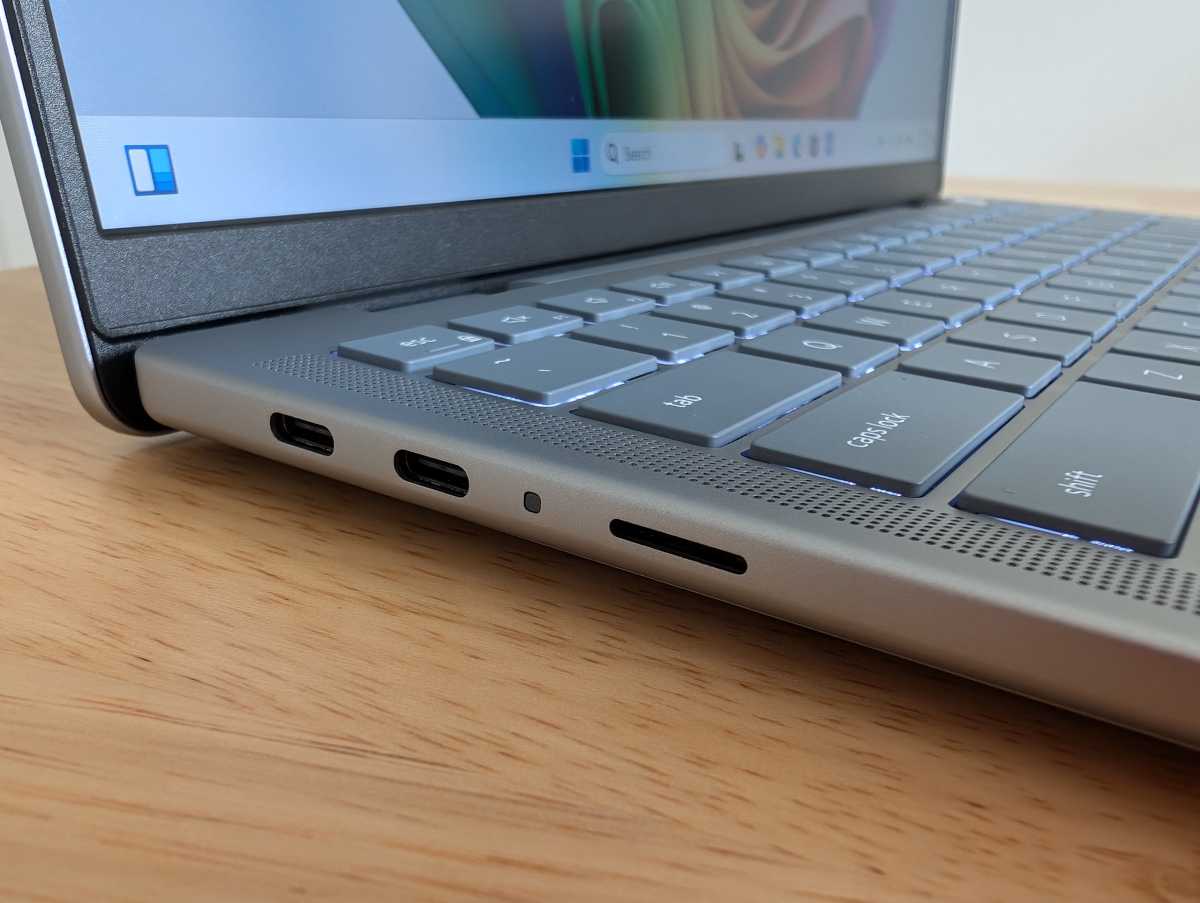
IDG / Chris Hoffman
The Dell Inspiron 14 Plus offers a reasonable selection of ports. On the left side, you’ve got a microSD card reader as well as two USB Type-C ports – these are USB4 “Full Function” ports that support 40Gbps transfer speeds, Power Delivery, and DisplayPort. You will be plugging the charger into one of these ports to charge the laptop.
On the right side, you’ve got a USB Type-A port along with a combo audio jack. It’s a reasonable selection of ports on a thin and light laptop.
Like other Qualcomm Snapdragon X-powered Copilot+ PCs, this machine includes Wi-Fi 7 and Bluetooth 5.4 support. However, Windows 11 only supports Bluetooth 5.3 at the moment. The Wi-Fi worked well, although I don’t have a Wi-Fi 7 router set up to test the latest standard yet.
Dell Inspiron 14 Plus: Performance
Like other Copilot+ PCs with Qualcomm Snapdragon X Plus or Snapdragon X Elite hardware, the Dell Inspiron 14 Plus works well in day-to-day desktop use, with snappy desktop application performance on battery power. It offers a great experience when using common PC productivity applications including web browsers, Microsoft Office apps, the Slack workplace chat app, and video-conferencing tools. The fans are nice and quiet in this type of day-to-day use, and the PC stays cool and quiet unless you push it hard, as we did in some of our benchmarks.
As always, we ran the Dell Inspiron 14 Plus (7441) through our standard benchmarks to see how it performs.
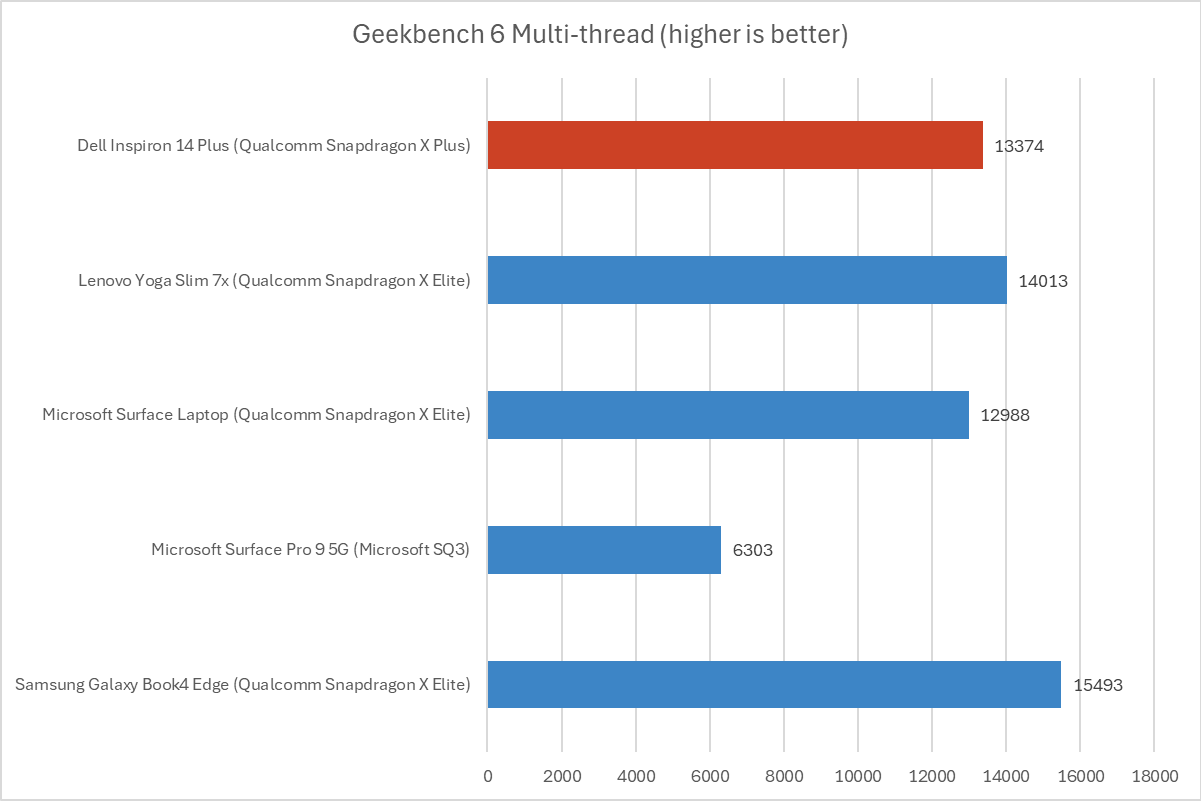
IDG / Chris Hoffman
First, we ran a CPU benchmark with Geekbench 6. We normally run PCMark 10, but it doesn’t run on Arm computers like this one. Geekbench 6 runs natively on ARM, so we can get an idea of this machine’s CPU performance when running native Arm code without Microsoft’s Prism translation layer playing a part.
The Dell Inspiron 14 Plus 7441 delivered a Geekbench 6 multi-thread score of 13,374. That’s a solid result and is right in the middle of the pack. Interestingly enough, it does beat the Surface Laptop’s Geekbench 6 score in our testing. That model of Surface Laptop we benchmarked has Snapdragon X Elite hardware, so it’s interesting to see the Qualcomm Snapdragon X Plus hardware performing so well in comparison to it.
The fans stayed nice and quiet while the native Geekbench benchmark was running. These machines tend to run hottest and loudest while running heavy workloads using x86 code through the Prism translation layer.
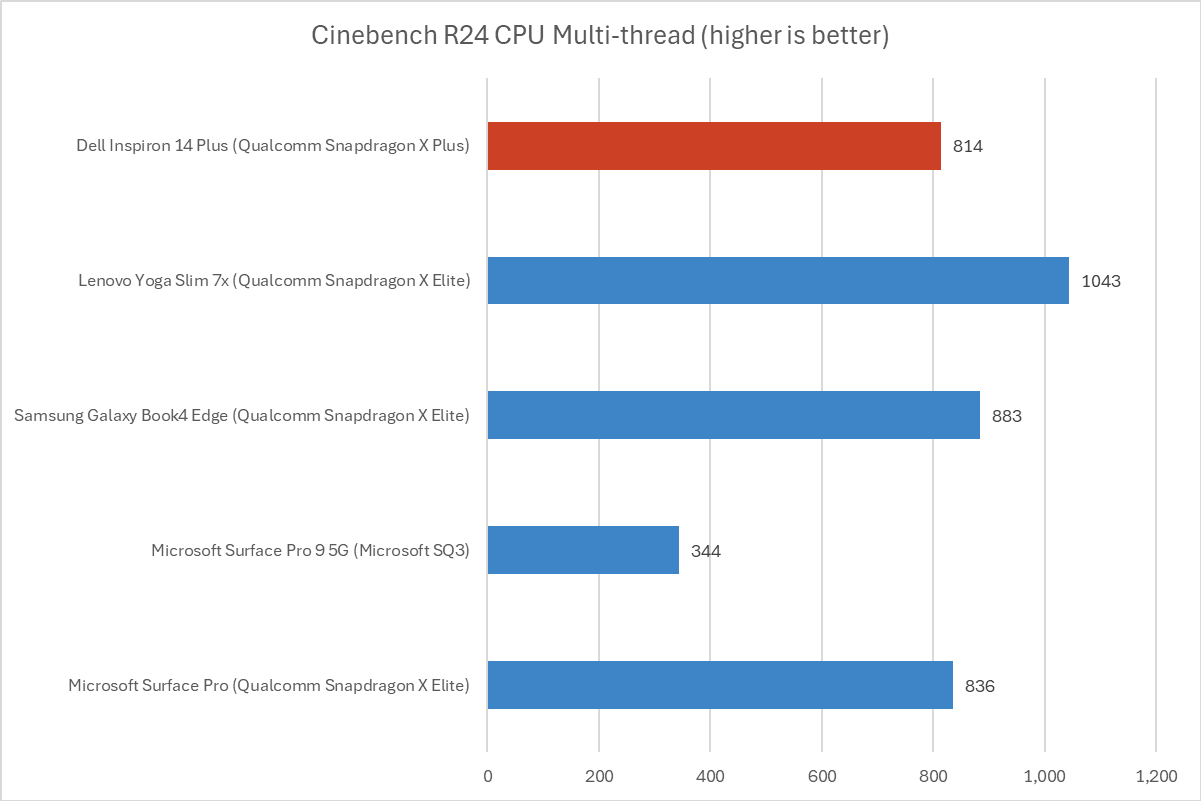
IDG / Chris Hoffman
Next, we run Cinebench R24. Cinebench R24 has a native Arm version, which means it isn’t running through the Prism translation layer. This is a heavily multithreaded benchmark that focuses on overall CPU performance. It’s a quick benchmark, so cooling under extended workloads isn’t a factor. But, since it’s heavily multithreaded, CPUs with more cores have a huge advantage.
The Dell Inspiron 14 Plus’s fans spun up while the multi-threaded Cinebench benchmark was running. On a Snapdragon X PC, they kick in to provide extra cooling for intensive workloads like the one in this test.
This machine delivered a multi-threaded score of 814. Unsurprisingly, that’s a little behind the Snapdragon X Elite-powered devices we’re comparing it to.
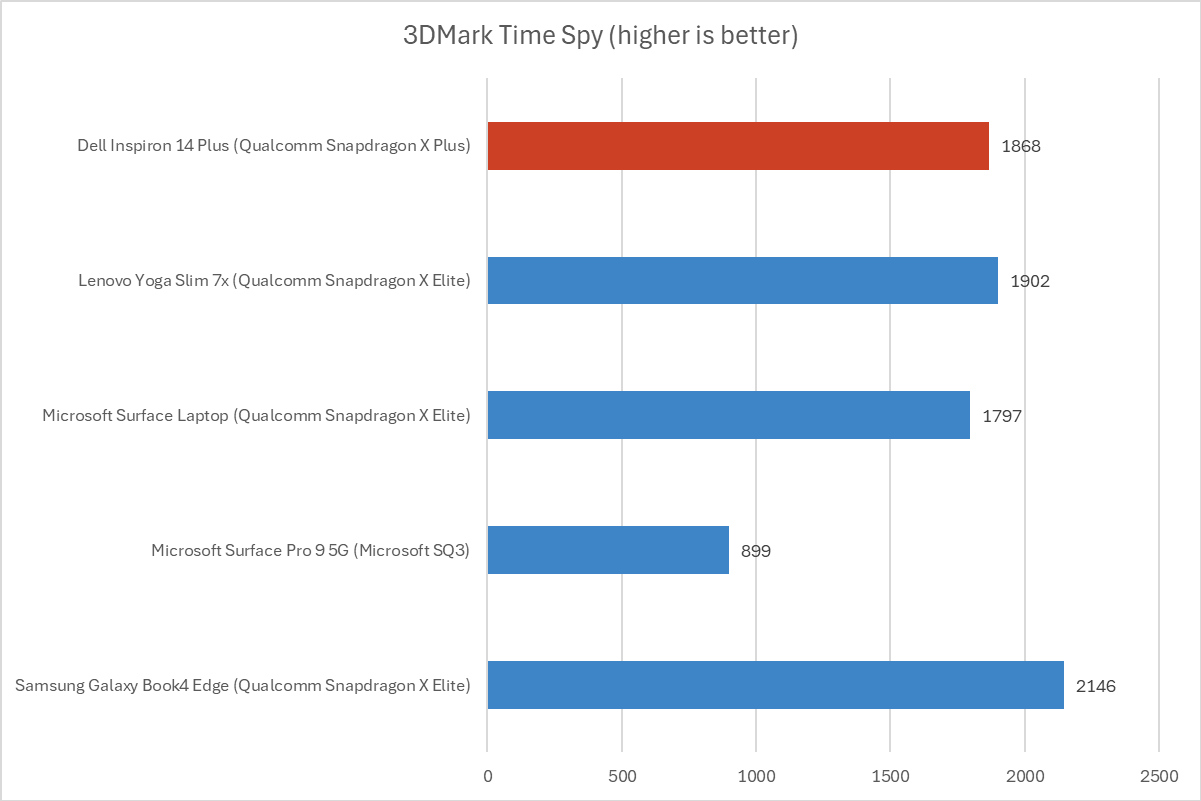
IDG / Chris Hoffman
Next, we run a graphical benchmark. Despite Qualcomm talking up gaming performance, this isn’t really a gaming laptop. We recommend against buying any Snapdragon X Plus or Elite powered laptop for gaming. Still, as always, we run 3DMark Time Spy, a graphical benchmark that focuses on GPU performance. We also run 3DMark Night Raid.
Time Spy is running through the Prism translation layer, while Night Raid is running natively on Arm. The pair of results shows the difference between x86 code translated with Prism and native Arm code.
With a 3DMark Time Spy score of 1,868, the Dell Inspiron 14 Plus came in right in the middle of the pack. (The Samsung Galaxy Book4 Edge we tested had the highest-end Snapdragon X Elite hardware with an upgrade Qualcomm Adreno GPU, hence its advantage). The Surface Laptop with Qualcomm Snapdragon X Elite runs a tad behind the Dell Inspiron 14 Plus once again — perhaps that’s a cooling issue. It’s a good argument for getting the base model Surface laptop with Snapdragon X Plus hardware — the machine doesn’t seem to be taking a lot of advantage of that Elite hardware.
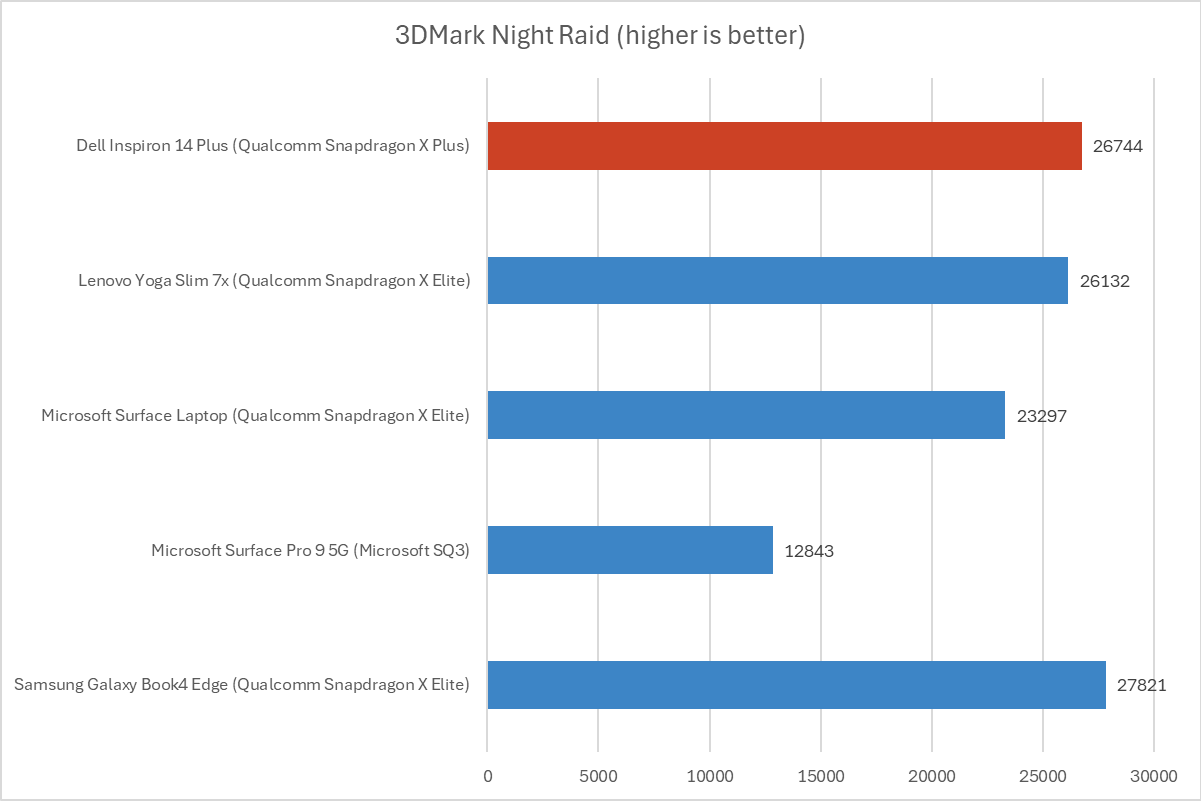
IDG / Chris Hoffman
When we ran the Night Raid benchmark, the Dell Inspiron 14 Plus delivered a score of 26,744. That’s on the high end compared to the average Snapdragon X laptop, which is impressive. This machine is a bit larger and heavier than some of its competition, so I imagine the cooling is helping it deliver higher performance.
Remember, the Dell Inspiron 14 Plus with Snapdragon X Plus has the same GPU as most Snapdragon X Elite laptops — except the Samsung Galaxy Book4 Edge with its top-end GPU.
Overall, the Dell Inspiron 14 Plus delivers strong performance for a Snapdragon X Plus system and seems to have a good cooling system. The CPU performance is a tad on the slower side compared to most Snapdragon X laptops, but it’s not a major issue — and it even seems to pull ahead of the Surface Laptop. Overall, Snapdragon X Plus hardware seems like a perfectly fine configuration for most people. These machines are best with light desktop productivity usage, and there’s not a huge upgrade if you pay extra for Snapdragon X Elite.
Dell Inspiron 14 Plus: Battery life
We expect Snapdragon X Plus and Elite-powered laptops to deliver long battery life in our benchmarks. The Dell Inspiron 14 Plus pairs its Snapdragon X Plus hardware with a 54 Watt-hour battery and that IPS display should help it deliver longer battery life than competing laptops with OLED displays, which tend to use more power.
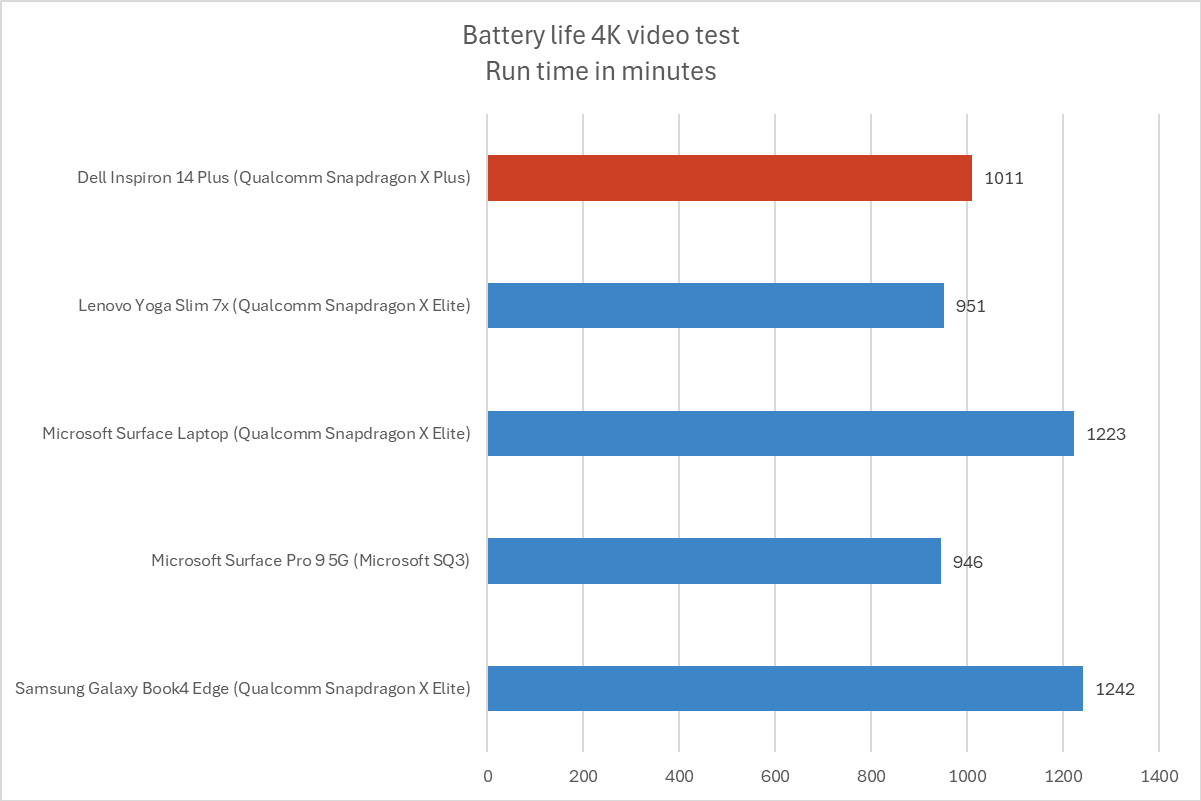
IDG / Chris Hoffman
To benchmark the battery life, we play a 4K copy of Tears of Steel on repeat on Windows 11 with airplane mode enabled until the laptop suspends itself. We set the screen to 250 nits of brightness for our battery benchmarks. This is a best-case scenario for any laptop since local video playback is so efficient, and real battery life in day-to-day use is always going to be less than this.
The Dell Inspiron 14 Plus lasted an average of 1,011 minutes or nearly 17 hours in our battery run-down test. That’s behind Microsoft’s Surface Laptop, which posted a result of 1,223 minutes or over 20 hours. Those numbers are so large that both sound fine, but remember that these are best-case scenario numbers and you will get substantially less runtime while you’re actually using the PC. The Surface laptop gives you some extra margin to work with, and that may make all the difference.
Dell Inspiron 14 Plus: Conclusion
The Dell Inspiron 14 Plus (7441) is a perfectly fine Copilot+ laptop with Snapdragon X Plus hardware. It has decent build quality, a nice keyboard, and good speakers. If you’re looking for an Arm-based Windows laptop, you can’t really go wrong with it.
Still, I don’t think this laptop makes a ton of sense at its normal retail price. The Surface Laptop has similar hardware, a more premium build quality with no plastic, a much brighter display with a higher refresh rate, and a haptic touchpad that feels great to use. The Lenovo Yoga Slim 7x doesn’t cost much more than this machine and delivers a beautiful OLED display along with very reasonably priced storage and RAM upgrade options.
The Dell Inspiron 14 Plus (7441) does have a few features the Surface Laptop doesn’t have, like a slightly larger display, a fingerprint reader, and a presence sensor. Still, at the same price as a Surface Laptop, I would recommend Microsoft’s hardware at this price point. It’s true that the 512 GB Dell Inspiron 14 Plus model we reviewed costs $1,099, while the equivalent Surface Laptop costs $1,199. However, the base-model Surface Laptop at $999 has equivalent hardware to the base-model Dell Inspiron 14 Plus, and that base model is a good choice for many Copilot+ PC buyers.
But the story doesn’t end there: As I wrap up this review, Dell has the Dell Inspiron 14 Plus on sale on its website. The 512 GB model with Snapdragon X Plus is down from $1,099 to $899. That’s $100 cheaper than the base-model Surface Laptop and with double the storage. Or, you can get the base-model Inspiron 14 Plus laptop with 256 GB of storage for $849 — that’s $150 cheaper than the base-model Surface Laptop and with similar specs. It’s a good deal!
If the normal retail price was that compelling, this laptop would stand out.

